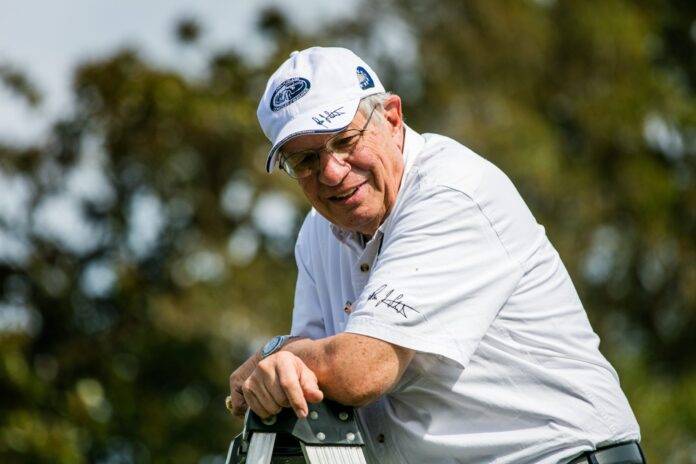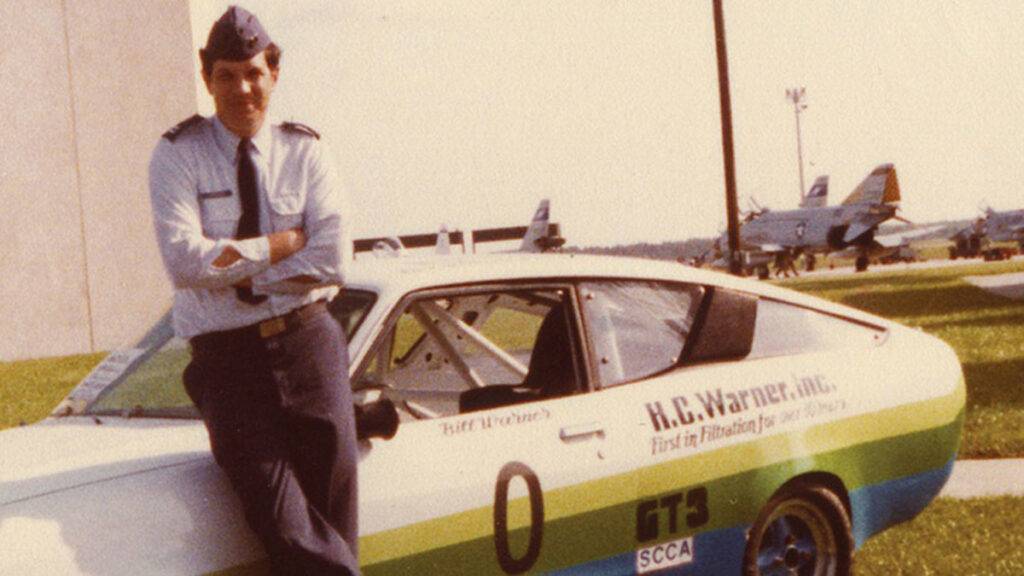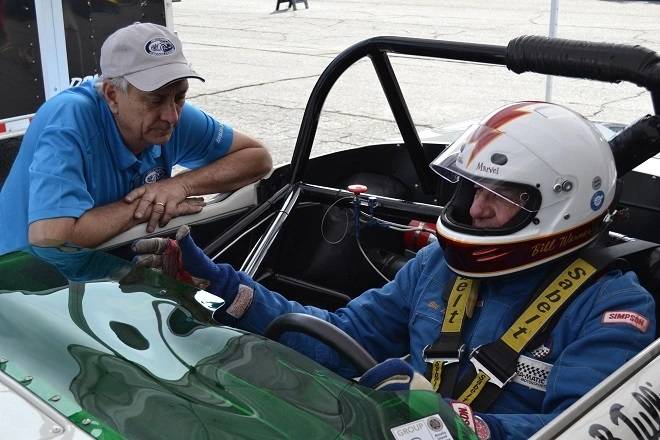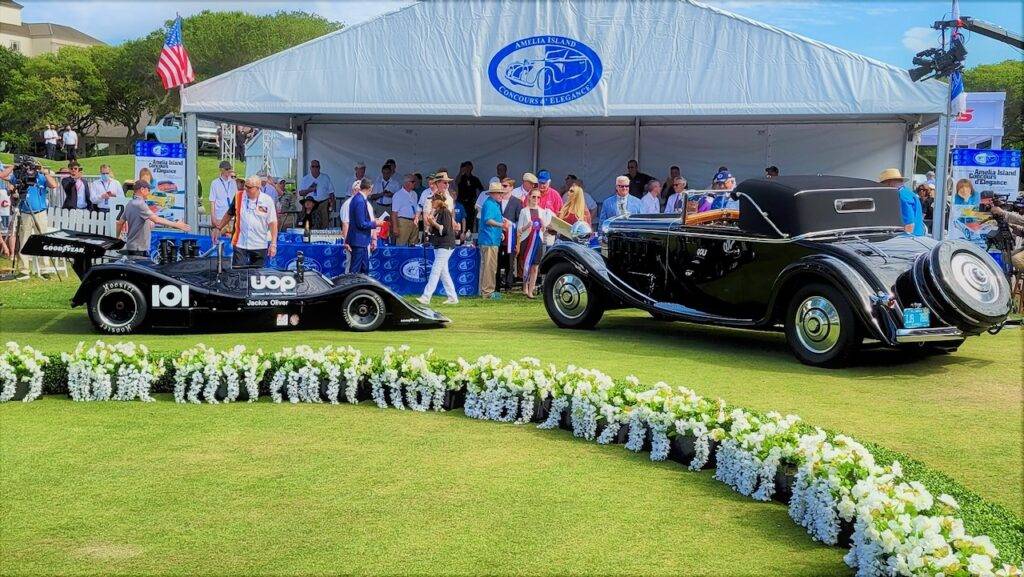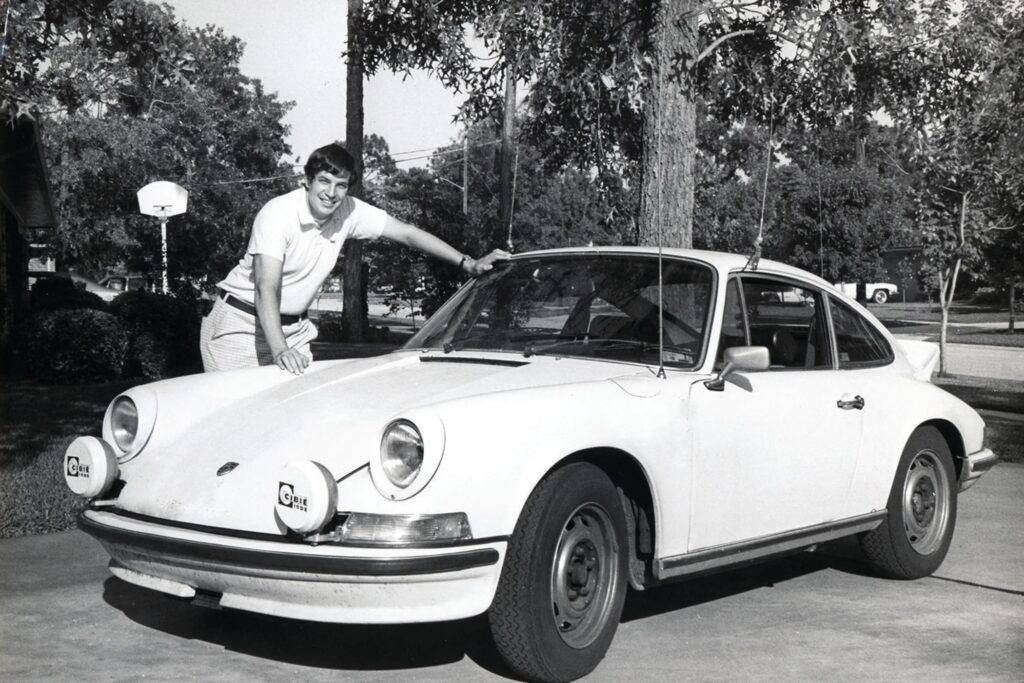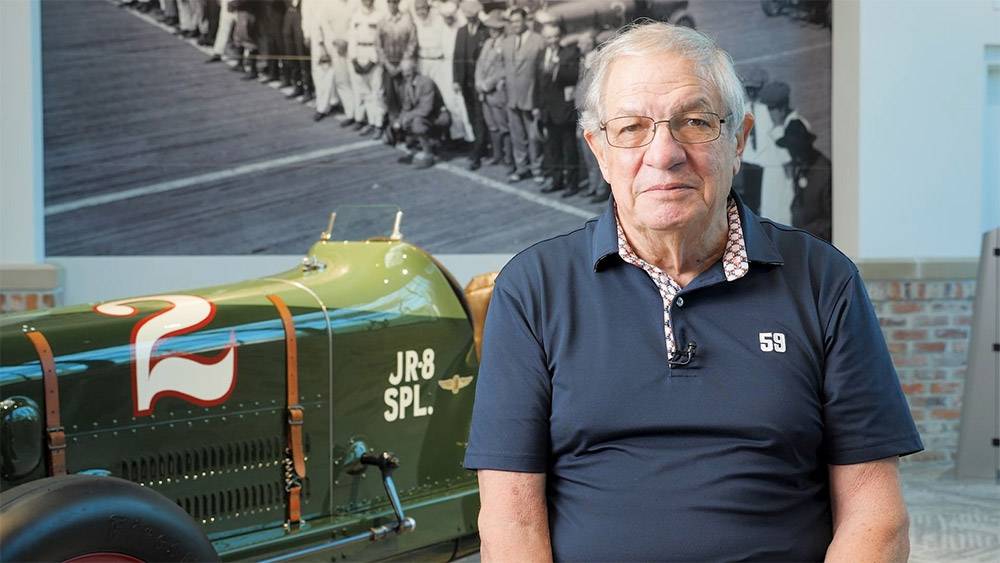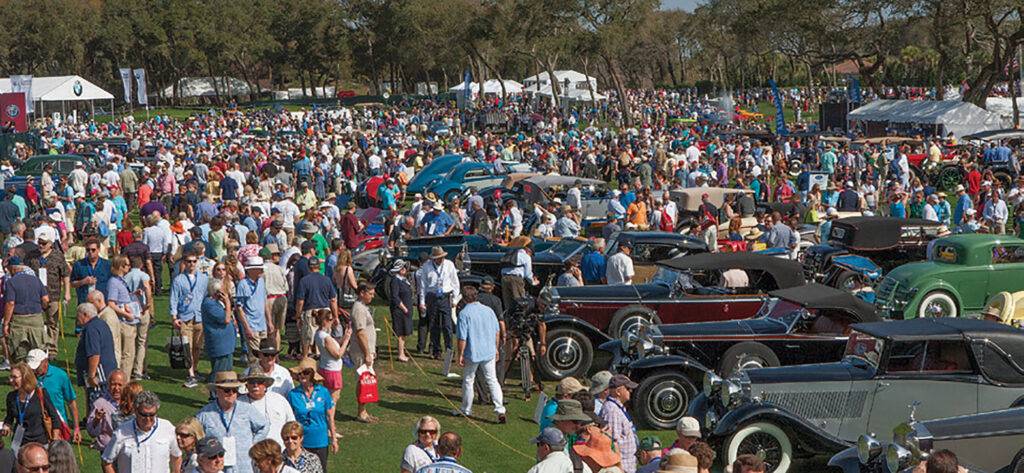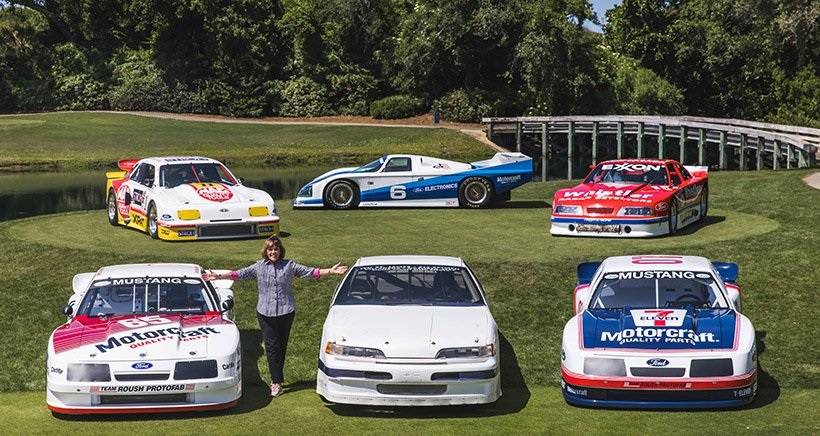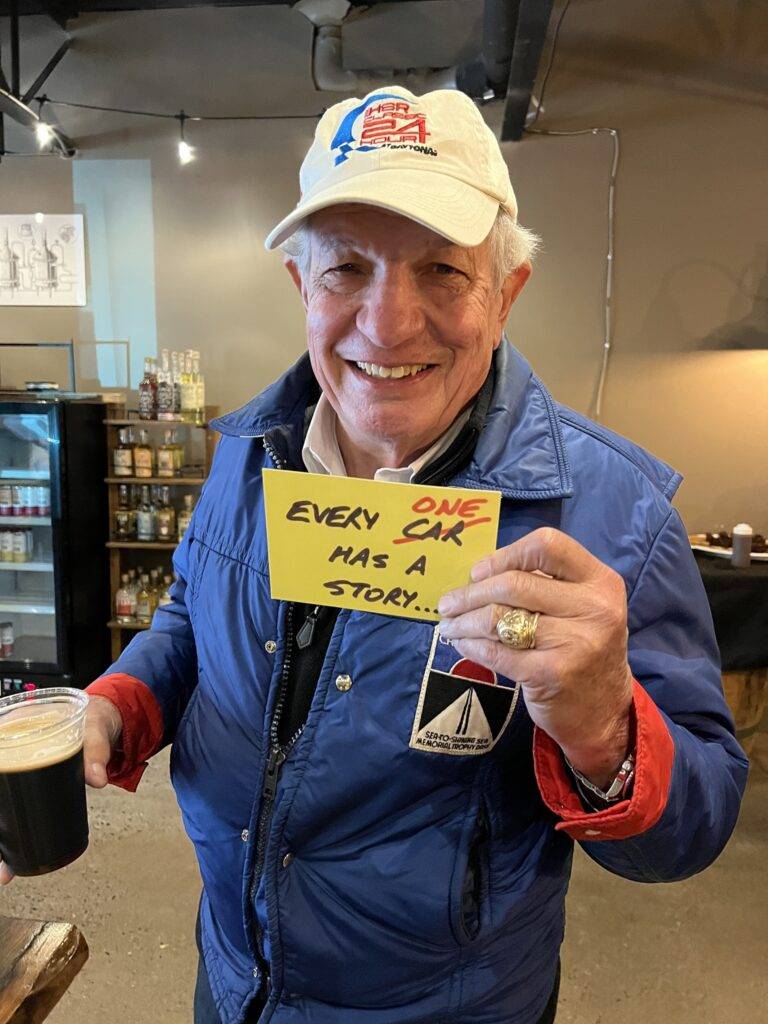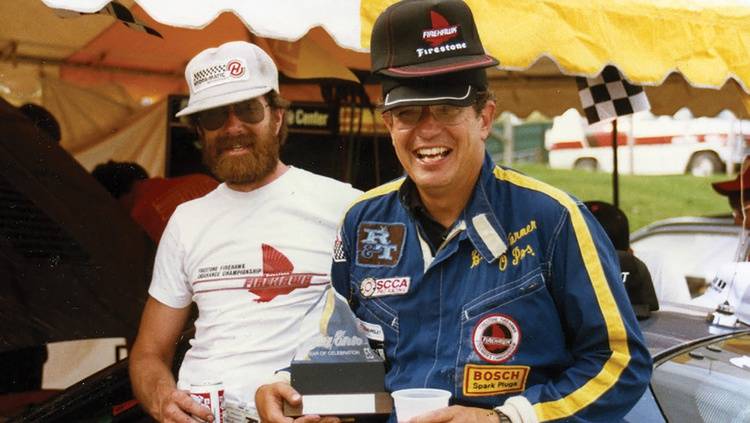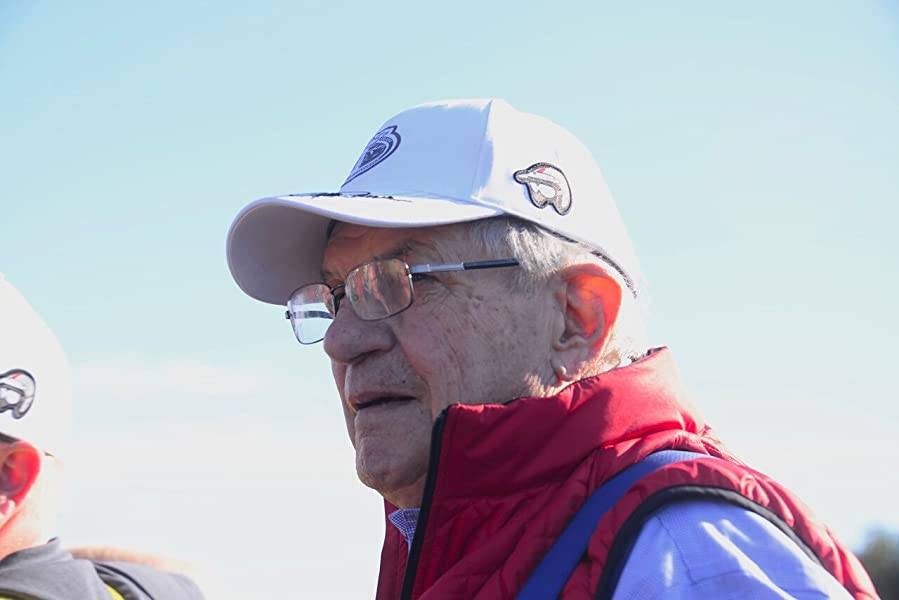Tonight’s guest has been around automobiles his entire life. On weekends, he worked as a “gopher” for the dealership racing team and became enthralled with motor racing. His photographs and writing have appeared in Road & Track, Car and Driver, Autoweek, The Atlantic Monthly, Automobile, Automotor und Sport, Classic & Sportscar, Porsche Panorama, and Forza to mention a few.
He has competed in the Cannonball Baker Sea-to-Shining-Sea Memorial Trophy Dash known to many of us as just “The Cannonball Run” as well as the Firestone/Firehawk series, winning the IMSA Media Challenge (for racing journalists) in 1984-1986. And if that wasn’t enough he also restores and collects interesting cars.
Who exactly are we talking about? Acclaimed author, photographer, racer, car collector and all around petrol-head… none other than Bill Warner, who in 1996, also founded the Amelia Island Concours d’Elegance near his home of Jacksonville, Florida.
Editors Note
A personal note from the Author (Don Weberg): I met Bill Warner over an email discussing Garage Style Magazine covering his Amelia Island Concours d’Elegance in 2012. I was a little apprehensive meeting him, as he was a big shot Concours boss, and I was a tiny publisher of a tiny magazine. I had nothing to fear, right?
Bill got right to business connecting me with his media pro who arranged everything and then called me. The big shot Concours boss was calling on little ol’ me. With a soft, understated tone and a thick southern accent, Bill complimented Garage Style, me and my crew who brought it together. We talked about cars and racing, and Concours and publishing, and that’s when I learned how extremely multifaceted Bill was in the car world.
He was more than a Concours boss, he was a great car guy. He spent a lot of his prior years working for magazines, something that impressed me more than running the Concours. There was no ego, no falsities, he was just “car-guy Bill” putting on a show to benefit Hospice of North Florida among other beneficiaries.
When my friend, Tony, and I went to the Amelia Island Concours that year, Chevrolet hooked us up with a new, bright red Corvette Grand Sport. We were in a slice of heaven – a Vette, north Florida in early spring, the Concours, and spending time with Bill who, after the Concours, took us to many of his friend’s garages – I really wanted to photograph them all, but stupidly was so overwhelmed by his generosity and that of his friends, I couldn’t think straight.
We got to see the back room at Brumos! Unreal. Bill drove a C-Class Mercedes-Benz diesel at the time, a car that amounts to basically a German rest-of-world taxicab, and I’ll tell ya, he’s a race driver. I’m okay behind the wheel, but Bill in his taxi made effortless escapes from us through traffic as he simply left Tony, me and the mighty Corvette in the dust. Amazing driver.
Since then, I’ve considered him a very good friend. He’s one of the best humans on earth. And an awesome car guy. Enjoy his story!
Spotlight

Notes
- Let’s talk about Bill, the petrol-head, like many of us… you got your start in Volkswagens?
- Talk to us briefly about your book, The Other Side of the Fence. Were you a racer or a documentarian first?
- 1975 – the original Cannonball Run – what made you decide to take on that challenge? What was the experience like? What were some high/low points of that cross-country journey?
- In 1984 he entered the International Motorsports Association Firehawk Series – we interviewed Andy Pilgrim a while back, and if our chronologies align correctly you would have competed against him in the Firestone/Firehawk series, right?
- In the intro we talked about how you have a collection of “interesting cars” – let’s explore what’s in your stable?
and much, much more!
Transcript
[00:00:00] Hello and welcome to the Gran Touring Motor Sports Podcast Break Fix, where we’re always fixing the break into something motor sports related. The following episode is brought to us in part by Garage Style Magazine. Since 2007, garage Style Magazine has been the definitive source for car collectors, continually delivering information about automobile petro events and more.
To learn more about the annual publication and its new website, be sure to follow them on social media at Garage Style Magazine or log on to www.garagestylemagazine.com because after all, what doesn’t belong in your garage.
Tonight’s guest has been around automobiles his entire life. On weekends, he worked as a gopher for the dealership racing team and became enthralled with motor racing. His photographs and writing have appeared in Road and Track, car and Driver Autoweek, the Atlantic Monthly Automobile Auto Tour on Sports Classic [00:01:00] and Sports Car, Porsche, Panorama, and Forza.
To name a. He has competed in the Cannonball Baker Sea to Shining Sea Memorial trophy dash known to many of us as just the Cannonball Run, as well as the Firestone Firehawk series, winning the IMSA media Challenge for racing journalists in 1984 through 86. And if that wasn’t enough, he also restores and collects interesting.
So who exactly are we talking about? Acclaimed author, photographer, racer, car collector, and all around Petrolhead. None other than Bill Warner, who in 1996 also founded the Amelia Island concourses to Elegance near his home of Jacksonville, Florida. And we welcome him to Break Fix, to share some amazing stories with all of you.
So welcome to Break Fix. Thank you. I, I don’t know how amazing they’ll be, but, we’ll, we’ll make up some stories. . That’s the first thing we learn is racers, right? Making up excuses and making those stories. What did they say? The older I get, the faster I was . [00:02:00] So let’s talk about that. Let’s talk about how you got your start.
I hear rumor that you actually got your start in Volkswagens. Well, I worked for Al Sager Volkswagen when I was 16 years old, driving the, uh, parts truck and the courtesy truck, which was a, a Volkswagen Combi and he had a racing team and they had, uh, two Porsche powered specials, both with, uh, one had a cobbled up Devon body and one with a stock Devin body.
I used to go to under the race and when I was 16, 17, this was before there were restrictions on getting into the paddock at 18, and I’d schlep tires and get coffee and you know, do whatever they needed to get done and smell that castor bean oil and heard the noise and that was hooked for life. Did you start your career in Motorsport first, or in journalism First it was Motorsports working for Mr.
Sager. I graduated from the Citadel in Charleston, which is a, a very strict military college, and I found out if, if you were a, a photographer on the yearbook staff, you didn’t have to march in parade. On Friday I became a photographer. My sister was a [00:03:00] professional photographer and my, uh, parents gave me a camera when I was 16.
And I would take it to the races. And then I couldn’t afford to go racing when I was first married at 23. So I started working for sports car graphic magazine, shooting races at Daytona magazines being historically cheaper to hire me to come from Jacksonville to Daytona. That was to fly someone from Los Angeles.
I think the first paid job I did was the S E C A runoffs, I think in 67, I think at day. It just kind of took off from there. Then in 1971, sports Car Graphic was eliminated from the Peterson Group. Roden Track was looking for somebody down here, so I went on and Roden track. I couldn’t make a living working for those guys.
I had a business on the side, not a side business, a primary business selling filtration equipment. So when did you get into racing cars and what did you race first? Uh, my first race car was a Braham b t eight, and I ran the very first or second vintage race at Seabring, Florida at 78. And I found the car in the South Carolina junkyard when I was on the road selling filters.
I’d go to [00:04:00] junkyards and repair shops looking for cars. Strangely enough, I, I was looking for a birdcage Maserati. ran into a friend of mine in a newsstand in Columbia, and uh, we were talking about bird cages. I said, I was looking for one. He said, oh, there’s one in a junkyard here. So I asked him how long it would take to get there, and he said, 10 minutes.
I said, let’s go. So we went out there and it was a four 50 s and it was dawn, but the guy says, I gotta grab ’em. I said, well, I’m not interested in the formula car. And he says, no, this is a sports racer. And I went out and bra ’em, made two sports racers, a BT five. They made two of those and a BT eight.
They made 12 of those. And this was the BT eight that Denny home won the tourist trophy. And it was undefeated and under two liter racing, and he was just sitting there in the South Carolina junkyard, so I bought it for 2,900 bucks. If we’re watching our years correctly here, you would’ve started your Motorsports career three years after the inaugural Cannonball Run, which was in 1975.
How did you get involved in the Cannonball Run and what made you decide to take on that challenge, but what car did you run during the race? I knew Brock Yates through my connections at Road and Track. He [00:05:00] was a car and driver. He and, uh, John Graves were in town one time. John won the Daytona 24 hour in the Escargo Porsche, and we ran a go-kart track and go racing at night and then we’d go drinking at night.
So between drinking and racing, Brock said he was gonna run another cannonball, and I’d never been to California at that time. I was, what, 32 years old. And it just seemed like a good idea to. So I had a Porsche nine 11. I bought in 71, so it was four years old. And we put a 31 gallon gas tank in it from uh, George Olson’s Carrera and a radar detector.
And Tom Neil, who owned the GM C truck dealership, who I later raced Camaros with, he and I decided to do the cannonball just for grs. We didn’t have any particular aspirations of winning. In fact, we made some bad decisions on the route. It was just alert. We never thought it would be a cult thing years later, but we just did it for how long did it take you?
41 hours. We were terrible. We went to Southern Route. One of the deals were that you had to agree with with Brock that you wouldn’t discuss when it was gonna happen, and [00:06:00] some clown from Ohio bragged about it to a newspaper which published it. And the Ohio and Indiana Highway Patrol were gonna be out looking for us.
So we decided to go down through Knoxville, Tennessee, and across Arkansas to Oklahoma. where all the roots came together and that was a bad decision. That cost us two hours. We would’ve been in about 39 hours had we gone the, the route everybody else ran. But we thought we were too smart for that. How far could you go on 31 gallons.
How often did you have to switch drivers? Uh, 600 miles . Farther than our bladders would go. So how long were your stents behind the wheel? Obviously with two men in, in the car, you can switch off. That’s a funny. . I started in New York and it was about seven o’clock in the evening. And along at about two in the morning we were down in Virginia and I turned it over to Tom.
I noticed his head was bobbing like he was going to sleep. And I said, what’s wrong? He says, never could drive at night. I said, well, it’s a heck of a time to tell me that, and we still got 2,400 miles to go. So I drove from New York City to uh, Knoxville, Tennessee, and then he drove to I think Little Rock and [00:07:00] then, uh, I drove from somewhere west of Little Rock to Needles, California, and he woke.
And then he drove from needles into, uh, Portofino Inn at Redondo Beach. I got where I was pretty wasted. By the end of that trip, the nine 11 was reliable the whole way through. No issues. Oh yeah. Oh nine elevens a bulletproof. What were some higher, low points during that cross country journey? . Well, all the roots came together in Oklahoma City and we had a list of all participants with their CB handles.
And my license plate, Florida license plate is Shazam. My CB handle is Captain Marvel. And I had just signed off with a trucker going eastbound, and I said, uh, the Captain Marvel were gone. And I hear this, how about you Captain Marvel? I said, who we got there? He says, the Sundance. I looked down my list and I couldn’t find a Sundance.
I said, uh, I don’t know any Sund. He came back, he says, does a Portofino Inn mean anything to you? And I said, oh yeah. So I knew it was one of the other Cannon ballers, and it turned out to be a Ford van sponsored by Heiser Cycle Shop in Towson, Maryland. And they had a bed in [00:08:00] the back and they were running this, a econo line van or whatever it was.
Coast to coast and he says, what’s your 20 here? What’s your location? I said, we’re at the 62 mile market. I said, we’re at 64. I said, ah, geez. I said, we’re behind the van. We made a bad decision going to Southern Route. So I picked it up to about a hundred miles an hour and we were just west of Oklahoma City and I said, we’re at 64.
We we’re at the 66. I said, ah, he can’t be that fast. Let’s run up to about one 15. So we got one 15. I said, where’s 60? Where’s at the 68? I said, holy Toledo, that van must be flying. I went as fast as the nine 11 would go, which is right at about 130. I told him we were at 68. He was at 70. It turns out he’d been two miles behind us telling us he was two miles in front, hoping that we’d get caught by the police and he rushed through.
So, . That was kind of the funny thing to happen along the way. There were some guys who were really willing to run a lot faster than we were back then. The national speed limit was 55, and we were running mostly in the 85 to 90 range, thinking that we could almost talk our way outta that without having to go to jail.[00:09:00]
you get up in the triple digits, you’re, you’re gonna end up locked up. We just chose the wrong route and didn’t go fast enough here. Jack May and, and Rick Klein won it in a Ferrari, Dino, and even with some time with the sheriff in Ohio, they got in at, I think 37 hours, something like that. Ah, they were flying.
You gotta remember. We didn’t have G P s. We worked on something called a roadmap map where you folded it out, you know, you saw what route you were gonna take. The only thing we had was a CV radio and, and what they called a fuzz buster back then, which was a rudimentary radar detector. You get out to California, spend some time hanging out, and then you go home.
I’m sure you didn’t do it as quickly as going out there. I’m sure you No. My wife flew out and met me and Tom flew back. So we’re driving back and I get nailed by a California. Airplane trooper in banning, and a local judge had given me a badge for my license plate that said Fourth Judicial Circuit State Attorney’s Office, hoping that if I got stopped, the officer would look at that and see that I’m a state attorney and let me go.[00:10:00]
So we got stopped in banning and. Officer looked at my license plate and he says, oh, an attorney, huh? Wrote me a ticket right on the spot. . It wasn’t your last Cannonball run either. According to Don Weiberg over a garage dial, he says, you also ran the Cannonball in a Lincoln Town car. The one lap of America, ah, gates was catching heat from the editors of car and driver that if anybody got an accident, car and driver may be sued for being complicit.
So he devised this thing where we do one lap of America, starting out at Darien, Connecticut, going to Boston, Detroit, Seattle, Los Angeles, San Diego, El Paso, Houston, new Orleans, Miami, Jacksonville, Richmond, and back to Darien with one stop. We had one evening to sleep in Los Angeles. Otherwise it was nonstop around the United.
So we went to Audi and asked him for a car cuz George Olson who drove with me was a, uh, a Porsche Audi dealer. And they, they said no. So we went to Mercedes to see if they’d loan us a car and they said no. So we [00:11:00] rented a, her unlimited mileage Lincoln from Kennedy Airport. Walter Hayes, who at that time was president of Ford, was good friends with Innis Ireland who was driving with me.
Ennis used to, uh, race for Ford and Lotus. And so they sent us heavy duty springs and shocks and told everybody, don’t return ’em and don’t tell ’em where you. Took it up to Bill Mitchell’s race shop in Connecticut. We pulled the, the bumper guards off and mounted c b A headlamps on the car and put a fuel bladder in the trunk.
And the rule was we weren’t gonna drill any holes in Mr. Hertz’s car. So when it was all said and done, we, I think we had it nine days, eight days, nine days, something like that. We turned it in, it was 500 miles out, 10,160 in at $39 a day, unlimited mileage. So we ruined the unlimited mileage program for the world
When we picked up the car, they said, are you gonna return it where you picked it up? We said, yeah, we didn’t tell ’em we were gonna go to the four corners of. The United States with it. So it was kind of boring, but it was, you know, it was one of those larks you do just to do something different. I did the Mil Amelia twice.
Oh, oh wow. And I took [00:12:00] Frank Campanelli with me cuz he could speak Italian and we did it in a 56 St. Baker Golden Hawk. We had a ball, great guy to do it with. And then the last time I did the Mil Amelia, I did it with Paul Gould in his, uh, 29 Alfa Romeo 17. And neither one of us spoke Italian, but we got through it all right.
Driving a thousand miles of Italy. The mi you can’t really enjoy it too much. You know, we went through the Dolomites and I really enjoyed it, but uh, I would’ve liked to have done it at a more leisurely pace. I mean, that’s a heck of an adventure if you ask me, but I also hear that you still have your Porsche from that original cannibal run, bought it new in September, 1971 and still have it.
Yep. I bumped it up to a 27 with. And put some deep dish wheels off Peter Greg’s TransAm car and added a spoiler from George Olson’s. His Carrera and added a front boiler. Took the bumper guards off, cleaned it up a little bit. It’s, it’s nice looking purist would stick their nose up at it. I don’t care.
It’s my car. . Absolutely it is. You do what you like with it. [00:13:00] That’s right. Moving on a little bit, tell us about your look entitled The other side of the Fence. Well, actually, my first book was a book called Cubas Car Culture that I did with Tom Cotter. In 2000, we were gonna honor Sterling Moss on the 50th anniversary of his victory at Havana.
I did a little search on the internet and found the head of the Cuban Museum, the depositor, the automobile. Which is a very rudimentary museum in Havana. Congressman John Campbell from California’s, a good friend and a car guy, uh, went to the, uh, treasury department to get permission to go to Cuba on a study of the Cuban Grand Prix and, and automobile racing.
So I got approval by the, uh, I think it’s called a Bureau of Offshore Asset Control, went down to Havana and sued. I had five more trips to Havana after. Meeting the people of a, of a car culture down there and and finding some rare cars and finding out as much as I could about the Cuban Grand pr, which were running 57, 58, and 60 [00:14:00] Now.
They didn’t have one in 59 cuz of the revolution. It always infatuated me that they did this world-class racing in Cuba. They didn’t count towards the World’s Championship, but they got the best cars. They had Sterling Moss, Maston, Gregory Jack Braham, they’d Park Togo, Carol Shelby, the best drivers you could think.
All of ’em went to Havana to race years ago. A friend of mine named Claude Hacr, who was a photographer I used to shoot alongside, passed away and his widow called me and said, Claude always wanted you to have his negatives. So I bought the negatives from him, and in it were the Cuban races. So I had the images to illustrate the book, Tom Carter.
Dick Messer from the Peterson Museum, Scott George from The Resident Institute, Neil Raba photographer here in town. We all went to Cuba. The first trip was kind of a water hall. We didn’t find what we wanted, but the last night we found a gentleman there who used to work at the races, and the next time I went down, we went to his shop.
He had a. Really ratty 300 SL Gullwing, a 300 SL Roadster, a Chrysler GIA concept car, [00:15:00] Fiat double bubble, and an American sprint car. All of ’em jump not worth restoring other than for their VIN numbers. We thought, well, a good book to this. People always, they always say to me, boy, when Cube opens up, there’s gonna be some great cars aren’t there?
And I go, no, you get a better car in Valdosta, Georgia. These cars are bushing, diesels in them. They’re just terrible. Cuba was a very, very wealthy. Before the revolution. And it was the largest purchaser of Cadillacs outside the United States. Cause there was a lot of money down there. So there were cars that were left there and that’s what we were trying to ferret out what was left, particularly any of ’em that ran the Grand Prix.
So that was my first book, second book I did, I had a lot of people on me. Said, well, you’ve been around racing. I really shot my first race as a teenager in 50. At the net in Florida. Yeah, I saved all the negatives. So I decided to do a book called The Other Side of the Fence, and where that came from was my late sister, I lost her to cancer when she was 50.
She was a photographer and she taught my parents to buy me a camera for Christmas. I said, yes, Sheika D, it costs 46 bucks. And she said to me, you know what? [00:16:00] This camera’s gonna get you. And I said, no. What she says on the other side of the fence, meaning you had a press. So that’s where the title of the book came from.
That’s pretty awesome. And that’s a great tribute to your sister as well. That’s That’s fantastic. Yeah. Yeah. She was very influential in my life. She was the one that went to my mom and dad when I started racing and said, you only live once. Let him do what he wants to do. Cuz mom and dad did not like the racing.
We jumped back into the timeline. Here we find ourselves in the early eighties. 1984 to be exact, and you entered the International Motorsports Association, better known to many of us as M S A, the Firestone Firehawk series. And as it would turn out, we actually interviewed Andy Pilgrim as well, who talked, who talked about his experiences in the Firehawk Firestone series.
And if everything aligns correctly, according on my. it means you guys would’ve competed at right about the same time we did. I remember, well, he very good driver, went on to much bigger and better things than I ever did. I actually started racing not only in the Bravin B T eight, I decided I wanted to do some [00:17:00] semi-serious racing.
So I bought an ex Bob Sharp Dotson went racing in that, in, uh, I guess I started in 82. I was doing pretty good in that. I got to the runoffs in 82. My goal was to get to the national championship finish fifth after starting last when the starter motor. And then the next season, I started 83 at Seabring and got into a terrible accident, completely destroyed the car, put me in intensive care for eight days and home for three months.
And then I quit racing and my wife of 56 years came to me and she said, you really miss racing, don’t you? I said, yeah. She says, well, let’s go back. Just buy a bigger car and we’re buy your life insurance. So that’s when we went back to the Firehawk. The Firehawk had just started. So we ran, uh, Tom Neal and I bought a Camaro and had Bill Mitchell prep it and we went to sea ring and I guess I did about seven or eight years after that with Charlie McCarthy and his cars, bill Mitchell and his cars.
And the one Tom Neal and I owned, I guess I must have driven four different Camaros. Um, and I’ve got the one that Jack Baldwin and I ran at Watkins Glen. I bought that. [00:18:00] So it’s out in the warehouse. You mentioned the Bob Sharp Dotsons. Yeah. So does that mean that you also rubbed elbows with Paul Newman, who also ran a Dotson slash Nissan?
Well, not then, but later I was running a Firehawk race at Watkins Glen and Tommy Chicon, who was Paul Newman’s partner, was on a team with me of two Camaros and we were sitting on the wall. He says, you like old cars? I said, yeah. He says, I got Newman’s old t R six. I need to sell it. You on it? And I said, It was something like 12 grand.
The car wasn’t running, but it had three engines, three gear boxes, three rear ends, a set of body panels. So I bought the car and it turns out, and I had forgotten that Newman had bought the car from Bob Tulio at Group 44. So it was a two-time national champion. One with Paul Newman and one with John McComb at Group 44.
So I raced that car for 28 years, and it was a fabulous car. It was acid dip, tricked out. It was really, really, really quick. In fact, my proudest moment was lap and lime rock at a one minute flat, which was just four tenths of a second off at [00:19:00] Tulio. Best time there. I sold it. For one reason, I, I ran at a race at at Amelia Island on Fernandina at the airport.
And Ray Evernham was there with me, with Tommy Riggins, who used to run in, uh, Kelly’s. And they said, uh, we don’t wanna see you driving this car anymore. I said, why? He says, it’s got 1971 roll bar, 1971 seat, 1971. Safety equipment. If you get into any bad situation, you could very well be killed. So in the meantime, I’d bought the group 44 T R eight, the Transa GTO O car, and it has a nice roll cage and everything else.
So I sold the t r six to Adam Corolla cuz he collects Paul Newman cars. I missed that car though because it was so good. Everything that Group 44 did was. Just perfect. They also did the Jaguars and they were involved with the Audis as well. That’s correct. In fact, uh, Hurley Haywood, who lives here near me, uh, drove the, uh, Audis Group 44, administered the Audi program here in the United States and the Cuatro, and I believe, correct me if I’m wrong, they won the Trans Am with it, until they got banned
Yeah, well, the [00:20:00] all-wheel drive. They were praying for rain about every race they went to. They could waltz around anybody in the rain. Absolutely. And we actually interviewed Lynn St. James as well, and we asked her about the experience of competing against the Audis and it just got her all hot under the collar immediately just reliving the memories of the quote unquote Unfair advantage.
Yeah. All wheel drive, you know, and they were four door sedans. They didn’t look the piece like Lynn St. James in the, in the Mustang. These looked like mom and dad’s car and they smoked everybody, but Well, they had hunch stuck too. He is a master of the rain, Mike. Golly. I mean that guy is amazing. And he, and uh, who else was in that car?
He had Walter Royal as well, Walter Royal, and probably the most successful rally driver of our time. They had a really good team. But yes, that was a group 44 administered effort. So you ran that t r six for 28 years you said. So that puts you behind the wheels, still well into the two thousands. Are you still racing today?
Did you ever. Yeah, it was kind of funny. I wanted [00:21:00] something to run at Daytona, or two years ago in the Daytona, 24 hour heritage. I bought a Pontiac, a sedan Firebird off bring a trailer for 15 grand. My friend in Orlando, bill Bryant gave me a dark motor fort, which we had Savannah race engineering, freshen and Dino, and we go to Daytona with this old Pontiac TransAm car.
I mean, it looked, the piece, the looked the part of a 30 year, 40 year old car, a 30 year old. We qualified 20 out of 23rd and come Sunday morning we were six overall. First in class with this, what you might call a junkyard dog, which was a lot of fun cuz it started raining in the last hour and a lot of guys didn’t want to go out in the rain.
I said that rain doesn’t bother me, so let’s just keep going. That was fun. A Jim Downing from Atlanta, who I’ve known for a year, a great race driver, came up to me and says, you know, there’s people with fancier cars than you got and there’s people here going faster than you, but you’re having more fun than anybody.
I said, what have I got to lose? ? You’ve worked with and raced with a lot of famous people. Have you ever owned or operated your own race team? Well, I [00:22:00] own my own cars that we operate, but I wouldn’t call it a team. I used Steve Boyle used to build engines for Ruggles in Atlanta for the a Buick Indian Engines.
He lives here and, and he’s the guy that makes the car go and Mark Helmick here in Jacksonville built my motors. Tommy Riggins set up the car, but they were all independent shops. So Steve and I. Getting a GMC C and Hol the car of the track. So it wasn’t a real team. I guess the closest we got to it was when we were doing the Fire Hawk race.
Tom Neal and I owned the Camaro, but Bill Mitchell prepared them. Bill Mitchell Outta of Connecticut. You you could say we were a team then. Yeah. But I never owned my own. All the racetracks that you’ve been on, which is your favorite, and the other side of that, what’s your least favorite? Well, I like lime.
Because it’s short and it’s really fast. It rewards lesser powered cars. I like Road America. I like the old road Atlanta with a dip rather than the chicane in the bottom. I’m not wild about Seabring, but it could have been. I nearly kill myself there, so that would kind of slant. Opinion. Leaves a mark, right?
Yeah. I left a [00:23:00] Mark Daytona’s kind of uninteresting. Everybody wants to run the banking and kind of not, not much to it, but I’d say Lime Rock is my favorite. Watkins Glen in Rhode. Those three. You asked which track I didn’t like. I didn’t like Mosport Canada. That was not a favorite of mine. I raced there once, , at age 70, I decided I needed to build a motor, right?
You can’t be a car we need without building a motor. So Steve came over and it walked me through building a motor and we went to Road Atlanta and it was okay, but it wasn’t crisp. It just felt a little soggy, so the next race was mos important. I go up there and of course, coming from Florida, then I’m the fastest gun in the west.
Everybody’s shooting for me, and those Canadians knew the track. I’d never seen it before I get there. I’m just a slob all over the place trying to figure out what turn came up next. Fortunately, I qualified on the pole. Race started, made one lap, came down the hill at turn two, and the engine exploded.
Like you pulled a pin on a grenade and I went 180 degrees in my oil. And then the MEChA system flooded the engine compartment with [00:24:00] oil thinking, well, there’s no oil pressure. I better give it some And. When it did, it burst into flames. So I’m going down the straightaway backwards, probably about 90 miles an hour with flames flying outta the car.
And I’m thinking, boy, I’m a crowd pleaser here. Boy, the only thing going through my mind, cuz you’re strapped in, you can’t look behind you is a. How far was that wall? , but I don’t, that’s why I don’t like Mosport. I’ve driven Coda, although I don’t like it cuz it’s built for a Formula One car. It doesn’t favor an underpowered car.
Wouldn’t wild about that. So is there still a track on your bucket list one that you want to drive? I’ve driven on about every track that I’d wanna drive on. I think I like Midio. That was fun. One won a race there. Probably about the only race I ever won. Yeah, I guess that’s about it. So earlier, you name dropped some of the cars that are in your collection, right?
Your Porsche, your Triumph, and the Pontiac and a few others. Let’s talk about your collection of interesting cars and let’s explore what’s in your stables. So do you wanna kind [00:25:00] of enlighten. Couple years ago, I bought one of the original IROC Camaros, built by Banjo Matthews for Roger Penske’s iroc. And this car is the most significant of the IROs.
It was the one Al Unser drove twice, won the championship with Driven by Mario Andretti, Al Unser, Jodi Shecter, Jackie Eeks. And Neil Bonnet. So it’s got a great, great history and it won several IROC races. Got that. I got the IROC showroom stock car that Jack Baldwin and I drove at Watkins Glen. I got a 57 Cadillac El Dorado Barretts convertible 58 El Dorado bro.
With a stainless roof, a 32 Ford High Boy built in Fresno in 19 19 50. It’s flathead mercury dog dish, hubcaps dress ring, white walls, fabulous car. A 63 Buick Riviera that’s just coming out of the paint shop. A 71 Boattail Riviera, all black. We call it Darth Buick cause it looks like something Darth Vader would drive.
Uh, 2005 Ford gt my Porsche nine. A Ferrari Daytona, the [00:26:00] latest new car I got and I love it, is a Corvette c8. It is fabulous. People say That’s the best car for the money. I said, no, it’s the best car. Money or not. , if anybody’s thinking about buying a sports car, the new Corvette C8 is I, I highly recommend, I’m surprised you say that cuz there’s a lot of people that are still very hesitant about the C8 because they’re so used to the classic front mount rear drive layout of all the previous Corvette’s.
So breaking with tradition and going mid engine and you know, you hear the naysayers, well, it looks like an nsx, it kind of looks like a cheap Ferrari. You know this and that. What attracted you? Take on a Corvette did such a bold move away from what we all know. My comment to those folks is get a life.
Think about it. The engineering on it from the forage suspension pieces to the way they thought out the packaging, it’s usable. It’s got a Arun and a trunk. It’s got a great entertainment center. It’s got an adjustable suspension. It’s got a adjustable exhaust. It’s got so many different things. Zero to 62.9 seconds.
Top speed, [00:27:00] 195 miles an hour. No one’s ever gonna use that. I mean, The car is just about as perfect the sports car as you want. I’ve had people pull up and ask me if it’s a McLaren or if it’s a na. I don’t care what they think. I like driving it. Let me ask you this, and this will help us transition to the next part of the conversation.
Yep. In your opinion, what’s the most beautiful car of all time? 1938, Alfa Romeo 2,900 C. And the opposite side of that, what would you say is not, not as attractive? The, the ugliest car? Well, that’s kind of funny. I thought my t r eight was pretty ugly when it came out. I saw it in 19 79, 19 80, but I describe it as a, it’s like a, A woman you marry who’s not very attractive but can cook good.
You are the most unattractive. There’s so many. Yeah. Pontiac, Aztec, , . I asked Wayne Cherry, who was head of design at GM at that time, when I asked him one time, I said, Wayne, what were y’all thinking when you came out with the Aztec? And the answer was, well, it played well in the clinics . But you know, that [00:28:00] was back when General Motors had what they called vehicle line engineers, BLEs, and they had the last word statement on manufacturing.
So the designers would come up with a great design, but the v l E would say, well, you know, if we used a sunroof from the previous car, we can save $2 a car. So it makes the roof look goofy. And then they decided they needed more air coming in the front, so they made the front end look like some sort of a car of pumpkin.
and then they decided to save money on the wheel size. So they put these little dinky wheels on it. And when the BLEs were finished with it, it didn’t look a bit like what the designers had come up with. But I’ve also heard that Tom Peters was the head of design for the Aztec, who happens to be the gentleman that designed the C seven Corvette.
I was just with him. . I’m curious how we get from A to B, but maybe that’s a whole nother episode into itself. Right? I think it, it, the, the, it determines. Marketing and the, and the, and the division says they want in a package and then they gotta design a package for it. But that, that was a pretty good failure, I thought.
And I think the market proved that too. That and the Buick [00:29:00] Rendezvous, which is built on the same, uh, platform, weren’t General Motors, high watermarks. And the guy who really turned that around was Bob Lutz. And it started with the Camaro. He looked at it, you know, they used to have a be for tire chains for winter driving.
You’d put chains on your tires. Well, they don’t do that nowadays. They haven’t done it in. , but General Motors had a spec that said you had to have certain amount of clearance on each wheel and tire. So the cars always looked under tired, put big wheels and tires on it changed the whole, uh, perspective of the car.
And Letz came in and changed that. And if you remember at that time, Audi was coming out with cars where they pushed the wheels out, they flushed them up, the fenders, they filled up the window. Well, And it gave the car a great stance. That’s what General Motors was lacking till Bob Lutz got there and turned it around, you know?
And he had a hand at a lot of different companies. I mean, they say, he coined the term the ultimate driving machine. When he was at B M W, he was under Coco’s tutelage at Chrysler. Been at a lot of different places over the years and so good on him. Right? Yeah. You can say he is the ultimate car guy. I know that my friend Steve Steiner, who was uh, in the [00:30:00] Buick Studio, Said they’d go to staff meetings and lets, would be sketching cars and passing ’em down to says, how’s this look?
He was a pretty good artist, so he knew what he wanted and he, he knew what proportions should be and what the car should look like. And I think under Let’s General Motors turned some pretty dramatic corners in their design. Well, since you’ve written for so many different magazines and reviewed vehicles and dovetailing off of what we were talking about, you know, beautiful versus unattractive, what’s the most interesting vehicle that you ever reviewed over the years writing for the.
Well, most of the stuff that I did was on classic or what you’d call historic cars. Brian Redmond and I did a story on the Porsche 9 0 8 Long Tail Henry Manny. And I did a story on, uh, Jerry Sutterfield Veritas. Jerry said that if I did a story in Roden track, it made immediately, made the car, unsalable did a nice story with Dennis Sitis on uh, bill.
And the Devon Sports cars. I’ve had the opportunity to shoot a bunch of salons for Roden Track that were all interesting and [00:31:00] all enjoyable, and meeting the people involved with it too. You know, that was as important as the cars. Were there any that were, let’s say, underwhelming, where you were psyched up to see it and you got there and it was just kind of like, eh, not so much.
No. One of the interesting stories I did for Auto Week was there was a guy who made a car called the Giba Avalanche. It was a tricked up Porsche with mother of pearl painting and flared fenders and sloped nose, and we went down to Palm Beach to shoot the story. The guy was trying to sell cars, so Andy Gibb lived in Miami and he brought Andy out to buy the.
Andy told me, he said, I don’t have the money to buy the car. I don’t know why they have me out here. This is the Andy Gibb of the bgs, right? Yeah, yeah, yeah. They got Andy, a driver suit his name on. I mean, they were really jazzing it up, selling the car and they said, Andy, drive the car. So we got in the, in the, in the turbo cab.
So I get in, in the little seat in the back of the Porsche with a 24 millimeter. Nikon are going along and I notice he’s on the wrong side of the road and we’re going down the straightaway, coming up on a left-hand turn and he is doing about a hundred miles an hour. In fact, in [00:32:00] my book you can see the speedometer right at a hundred.
And I’m thinking there, well, I’m sitting in the back seat, no seatbelt, with a guy who’s never done this before. This isn’t the smartest thing I’ve ever done. I tapped him on his shoulder and I, and he slowed down. I You ever done this before? He says, no. I said, well, let me show you the line before both of us get killed in this thing.
It was kind of sad cuz he’d had a rough. And they, they thought he had wherewithal to buy these cars. It was just wasn’t a pleasant afternoon. It was pleasant to meet him, and he was a nice guy, but the situation wasn’t real Great. So, switching gears. Yeah. H how do you go from motor sports to concor? Wasn’t really a concore guy.
I don’t pick grass out of the tires. I got a call from the Ritz Carlton asking me if I’d do a concore. I go, well, I’d never done one, but I felt I used this line a lot. I said I was confident I could do it. And confidence is a feeling. You don’t truly understand the situation. I decided that we had two fairways.
and I liked racing, so we were gonna honor our racing heroes like Brian Redmond, Hurley Haywood, Carol, [00:33:00] Shelby, Sterling Moss, just name em. We had 26 of the greatest drivers in the world. Jim Hall, Bobby Unser Allen, or Yolk and Moss Houck, Johnny Ruthford. I mean, we, we had ’em all. My goal was to honor them, bring the cars that they drove, because there’s a lot of cars that are historic race cars that people won’t take out on a racetrack now, but they want ’em to be seen.
So we decided to do. Concord, Deon, it was a little off the wall. It was gonna be 50% about racing and 50% about classic cars. I think we were successful in bringing that off. It differentiated ourselves from other shows, and the focus was around our heroes. I wanted it to be so that if someone came to Amelia Island, they could walk up and shake hands and get a picture with Johnny Ruthford, Richard Petty, or Bobby Allison.
They’d have the opportunity to meet their heroes, and that’s where I think we had success. So would you say in the early days of Amelia Island, that it was a lot like the Goodwood Festival of Speed, at least on our shores? Well, we didn’t have a a speed component. We had the cars, but no track to run [00:34:00] them on.
I’ve been to both Goodwood, the festival speed and the revival. I love the Rev. I like it the best. It’s part theater. You have to dress the part to go there. You have to dress. Prior to 1963, I think it is, I was in the Air Force Reserve for 30 years, so I wore my uniform to get in and some lady killed, says, oh, little costume.
I said, lady, it’s sitting in a costume behind . I wore this 35 years ago. So you’re part of the theater, you’re, you’re part of the event, and that’s what makes it fun. Running up the hill is all right, but the event of the, the revival is the best in the. and the revivals where they actually do the track event.
Where they do on, on the circuit? Yeah. Yeah. Mm-hmm. . Why Amelia Island? Why that location? I live here, . I mean, I live 30 miles away. A lot of people ask me that question, why didn’t you go to Boca Raton? Why didn’t you go to a bigger senator? I said, you know, Jacksonville’s market’s about 1,000,600 thousand, so we’re a good sized city.
We’re equidistant between Atlanta, Birmingham, Charlotte, Miami, and Tampa. So we were drawing from about a 16 million. That [00:35:00] made sense, but we weren’t thinking globally. Later on, we found out that a lot of the competition we had wasn’t locally. It was like the Geneva Auto Show. If we were getting a new car.
And they were going to, uh, say General Motors when they did the C seven. The first showing was at Geneva the week before our show. Well, one car went to Geneva and one prototype came to us. It got where we had to think about, well, we never thought about Geneva, but they were kind of a competitor to us in getting new car rollouts.
and we always wanna do new car reveals. That was one of our goals. So the cars could be seen at our place first. Uh, Jacksonville is a, a wonderful car town. It’s the best car town in Florida. You’ll find more neat cars here, the Brunos collection, some private collections and some terrific cars. More so than I think, than in Tampa.
There’s some great collections in the Orlando area. I look on Miami as kind of the gold chain Gucci crowd, the shark truth, Lamborghini with the gold wheels, but we’re more of the traditional cars up. So Amelia Island concourses is often touted as the motoring event of the year. So [00:36:00] how do you compare and contrast Amelia to some of your competitors, as you mentioned them, and what are some of the unique things about the Amelia Island concourses that have come up over the years?
Of course, I’m out of it now. It’ll change according to the new owners, which are Haggerty. What I always did was each year I’d do what I call a goofy class. It would be a class for people. We were drug out to a car show who didn’t want to go to a car show but wanted to be entertained. So one year we did the cars of Big Daddy Roth, the Hot Rods, the Orbi, the beatnik Bandit, those kind of weird cars from the fifties.
That was very entertaining because we’re on the beach. We did beach cars, Fiat jollies were no jollies. You know, unusual cars built for the. Then one year we did great hunting cars and I worked 10 years on that to get the King Ranch Buick, which had never been seen. A 1950 four-door Buick convertible with car in the fenders, a bar in the back seat, radio, telephone, you know, never been seen.
I worked through, uh, my friend Richard Atwell and Bobby Smith in Gainesville, [00:37:00] Texas to get the King Ranch people to agree to let us have that car cause they’d never been up to King Ranch since 1951. The thing I always tried to do is, one, a goofy class that would entertain people, cars of the Cowboys with the, the, the silver dollars and the horns and all that.
You know, the Roy Rogers car, the Gene Autry car, the Hank Williams. One goofy class, one significant race car class, Porsche 9 62. Cars and art. We tried to do themes that were entertaining. Even the people who don’t like cars, a lot of concourses have beneficiaries. Was there a beneficiary for the Amelia Island?
Oh, yes. Oh yeah. We were always a charitable foundation. We were never a corporation. We were a charitable corporation. It started out with community hospice and palliative care for terminally ill, and then our granddaughter was born spina bi. Which is a very crippling birth defect. So we expanded to spina bifida and this year I’m closing out the foundation and we’re gonna be writing checks totaling nearly a half a million dollars.
Uh, they’re gonna go to the paralyzed American Veterans Mayo Clinic Community Hospice, spina [00:38:00] bifida, and the, uh, Sulzbacher home for the homeless. So we always wanted to. What we call soft charities, not brick and stone charities, but charities that did something for people, whether it was in their dying years or whether they had been born with a a dirt birth defect, or whether life had thrown ’em some bad curves and they just needed help.
That’s where we wanted the money to go. A lot of us understand how you can buy and sell a car. We do that all the time. But you mentioned earlier, you’re out of it now. How exactly do you sell a concore? Well, you can’t sell a found. So we rolled the foundation, Amelia Island Concord Deon’s Foundation into the Haggerty Foundation, and then my wife and I with advice of our attorney.
25 years ago, we registered and owned the brand. So what we did was we sold the brand, which was Amelia Island, logo, brand, and intellectual properties. What made you decide to get out after 26 years? Almost, I’ll be 80 years old next year. You wanna work all year long work worrying about covid. Weather [00:39:00] sponsors that pull at the last minute.
Nah, man, I, I would check myself into the hospital a couple years, 60 days out, just over the stress of what was happening with the show, cuz I was rolling the dice every year on 3 million on the weather in two years. We had to move the show from Sunday to Saturday to beat the weather. And one year we had three days of bad weather, nine in 2003, which we barely survived, and friends passed the hat and kept us alive.
I just didn’t need that stress anymore. Sandra Caskey said to me one time, I don’t wanna die on the 18th fairway. I said, I understand that. You said it yourself. You’re still out there racing. You’ve closed the chapter on the Amelia Island concourse. So what is the next part of the Bill Warner story look like?
I’m writing for Wayne Corrina’s magazine, the Chase. I enjoy doing that. I drove with Charlie McCarthy Hughes to do offshore boat racing and we talked about and starting to work on a book about racing in the eighties and the drug trafficking kind of a fictitious book based on fact. I’m working on a third book.
I’m staying [00:40:00] busy. I’m working to sell the building I’m in and buy a, a building that’s a little bit bigger for my cars and a little bit smaller for offices. So I’m staying busy. I get up every morning. I’m here at the office at eight o’clock by. , that’s kind of different. I used to have nine employees here and it’s pretty quiet around here now, you know what a trip down memory lane.
But what an awesome, awesome career and just complete immersion into the automotive world that you’ve had, you know, starting from 16 years old, you know, out of a dealership. I mean, absolutely incredible. So I wanna give you the opportunity now to give any shout outs, promotions, or tell us any other stories that we didn’t cover thus far.
Well, I’ll tell you. When I was in high school, I was, I could have been thought of as a butt of jokes cuz I didn’t play sticking ball games. I was a klutz and I was small for my age. So cars were my kind of my escape, but they were escape. I really loved, I pedaled my bike to the car dealerships and collect the literature and take a camera and try to get pictures of the cars before they came out.
So I was totally [00:41:00] immersed in automobiles from the time I could remember, you know, from the tricycle days. My message to young people is, if you have a passion, For something, whether it’s tennis, golf, cars, airplanes, follow that passion, you’ll be successful. Whatever you do, just don’t give up on what makes you happy and, uh, what you enjoy doing, and don’t let what other people say affect you.
Just do your thing. You may not see the the root you’re gonna take in life early on, but it’ll become apparent as you travel it and you go, oh, that’s the reason. For example, I started shooting for a road and track and sports car graphic magazine. In doing so, I met a lot of my heroes, like Brian Redmond, Hurley Haywood, Carol Shelby, Roger Penske, who’s my hero.
I mean, there’s a man who has done everything and he is probably. Best businessman around. If you could make him president, it’d be great. That time period allowed me to do a concor, but I didn’t see it at the time. I was building relationships with people I could call on. When the [00:42:00] Concord came, for example, when we did it the first year, I said, we gotta get someone here that that’s recognizable.
So we got Sterling Moss first year and Sterling was was my racing hero. And then we closed the show out with Lynn St. James and the year before that Roger Penske. I feel so blessed to know these people and to have worked with these people and be on a first name basis with these people. But this started, in fact, when I was 10 or 12 years old.
So follow that passion. A lifetime devoted to motorsports and the vehicle enthusiast world. Bill Warner has been around automobile’s his whole life. If you want to learn more about Bill, pick up one of his books. Shop with them on Amazon or at your local brick and mortar bookstore if they still exist. Or flip through copies of your favorite car magazines as he’s still writing for various different automotive magazines that are out there.
And I can’t thank you Bill, enough for coming on the show and sharing stories with our audience and getting to know you a little bit better. One of our heroes in the automotive and motorsports world. Well, you’re [00:43:00] very kind. I, I, I never thought of it in those terms, but for those who, if they wanna buy the book, the other side of the fence, all proceeds go to spina bifida of Jacksonville.
All revenue that is generated from that book goes to that. I want to continue raising funds for spina bifida and the various charities. I think that’s important to give back in life. Thank you for doing this, and thank Don Weber for putting us together. Absolutely. My pleasure. Thanks. Thanks, bye. Now
the following episode is brought to us in part by Garage Style Magazine. Since 2007, garage Style Magazine has been the definitive source for car collectors, continually delivering information about automobile petro events and more. To learn more about the annual publication and its new website, be sure to follow them on social media at Garage Style Magazine or log on to www.garagestylemagazine.com because after all, what doesn’t belong in your garage.[00:44:00]
If you like what you’ve heard and want to learn more about gtm, be sure to check us out on www.gt motorsports.org. You can also find us on Instagram at Grand Tour Motorsports. Also, if you want to get involved or have suggestions for future shows, you can call our text at (202) 630-1770 or send us an email at crew chief gt motorsports.org.
We’d love to hear from, Hey everybody, crew Chief Eric here. We really hope you enjoyed this episode of Break Fix, and we wanted to remind you that GTM remains a no annual fees organization, and our goal is to continue to bring you quality episodes like this one at no charge. As a loyal listener, please consider subscribing to our Patreon for bonus and behind the scenes content, extra goodies and GTM swag.
For as little as $2 and 50 cents a month, you can keep our developers, writers, editors, casters, and other volunteers fed on their strict diet of fig Newton’s, gummy bears, and [00:45:00] monster. Consider signing up for Patreon today at www.patreon.com/gt motorsports. And remember, without fans, supporters, and members like you, none of this would be.
Learn More

A lifetime devoted to Motorsports and the Automotive Enthusiast world. Bill Warner has been around automobiles his whole life. If you want to learn more about Bill – pick up one of his book, or flip through copies of your favorite car magazines.
How do you sell a Concours? Easy!
During this episode we asked Bill about the process of building and then selling the Amelia Island Concours d’Elegance (now owned/operated by Hagerty, and known as “The Amelia”) with questions like:
- How do you go from Motorsports to Concours d’Elegance? What was the inspiration behind starting the Amelia Island Concours – known to many of us as “Motoring Event of the Year” – Give us the backstory/history of the Concours, its evolution and future.
- We understand how you can sell a car… but how do you sell a Concours?
Celebrating with Break/Fix guest Lyn St. James!
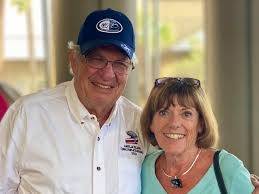
Bill has made friends with some fabulous people in the collector car and racing community. He even celebrated his birthday with Break/Fix guest Lyn St. James during the 2021 Amelia Island concours where her career and cars were celebrated at that event.
Biography of William (Bill) C. Warner
Born: 1943 | Education: BS Electrical Engineer, The Citadel, 1966 | Hometown; Jacksonville, Florida | Occupation: CEO, H.C. Warner, Inc. | Major (retired), Florida Air National Guard | Contributing Editor, Road & Track Magazine | Founder and Chairman, The Amelia Island Concours d’Elegance
Bill Warner has been around automobiles his whole life. As a teenager he worked at the local Volkswagen and imported car dealership in the parts department and driving the delivery truck. On weekends, he worked as a “gopher” for the dealership racing team and became enthralled with motor racing. Upon earning his degree in Electrical Engineering, he entered the family filter business and started work on the side for Sports Car Graphic Magazine. In 1971, he began his relationship with Road & Track Magazine which continues today. His photographs and writing have appeared in Road & Track, Car and Driver, Autoweek, The Atlantic Monthly, Automobile, Automotor und Sport, Classic & Sportscar, Porsche Panorama, and Forza to mention a few. His photography has won awards from The Los Angeles Art Directors, the Creative Arts Yearbook, and the Sports Car Club of America (Photographer of the Year 1970). His photos have been featured in the Petersen Museum in Los Angeles as part of the 50th Anniversary of Ferrari and at the Meadow Brook Concours d’Elegance, in Auburn Hills, Michigan.
In 1975, he teamed with Tom Nehl in a Porsche 911 to finish 14th in the third running of the Cannonball Baker Sea-to-Shining-Sea Memorial Trophy Dash (AKA The Cannonball run) and with English racing great, Innes Ireland; Can Am racer, George Drolsom; and sedan racer, Dick Starita, to finish 26th in the inaugural running of the Cannonball One Lap of America.
The One Lap was run in a Hertz-Unlimited Mileage Lincoln Town Car. Warner started racing in 1978 in a Brabham BT-8 and later in the SCCA in an ex-Bob Sharp Racing Datsun B210. He finished 5 th in the American Road Racing Amateur Championships at Road Atlanta in 1982 in Class GT-3 (having started in 22nd place). His drive earned him a nomination for the Mark Donohue Award.
In 1984 he entered the International Motorsports Association Firehawk Series in a Camaro and had top ten finishes at St. Louis and Sebring, top five finishes at Watkins Glen (twice), a 3rd at Road America, a 3rd at Lime Rock, Ct., and a win in the Escort Series at Mid-Ohio, all in Camaros. Warner won the IMSA Media Challenge (for racing journalists) in 1984, 1985, and 1986. He also drove in two “Longest Day of Nelson” in Ohio with Innes Ireland (1984) and Bob Akin (1983) in Jack Roush’ Fords. He participated as a driver in the SAAB World Speed Record Run at Talladega, Alabama in 1986. Warner has driven factory sponsored racer cars for Chevrolet, Oldsmobile, Mercury, and Ford. He currently races the ex-Bob Tullius, Group 44 TR-8 Trans Am/IMSA car in vintage racing. He has been awarded the Skip Barber Cup (Lime Rock) and the John Kelly Trophy (Mid Ohio) for driving.
In addition to racing, he restores and collects interesting cars. Currently in his collection are a 1957 Cadillac El Dorado Biarritz, a 1958 Cadillac El Dorado Brougham, a 1972 Ferrari 365GTB/4 “Daytona”, a 1971 Porsche 911T (owned since new), a 1979 Mercedes Benz 450SL (Jane’s car), a 1928 Simplex Piston Ring Special, 1985 IROC Firehawk Camaro (one he drove to a 5th overall in the 24 Hours of Watkins Glen), a 1990 Pontiac 1LE Firebird (ex-Firehawk/Players car),1978 Bill Mitchell Special Vehicles Development Oldsmobile Omega, a 2005 Ford GT, and the previously mentioned Triumph race car. The centerpiece of his collection was Edsel Ford’s 1934 Ford Model 40 Special Speedster which he sold in 2008. Over the years he has restored a Brabham BT-8 (ex-Denny Hulme, Tourist Trophy winner), an Elva Mk 5, a Lotus 11 LeMans (ex-Innes Ireland), the Lang Cooper (nee Shelby King Cobra), a 1953 Oldsmobile Fiesta (now in the General Motors Heritage Collection), a 1970 Maserati Ghibli Spyder, a 1954 Corvette, a 1955 Corvette, and a BMW M-1.
In 1996, he founded The Amelia Island Concours d’Elegance near his home of Jacksonville, Florida. In the twenty-five year history of the show, it has raised over $ 3.7 million dollars for Community Hospice of Northeast Florida, Spina Bifida of Jacksonville, The Navy-Marine Corps Relief Society, and the Shop with Cops Program of Fernandina Beach and Nassau County (FL). For his charitable work, he was recognized by The Rotary Club of South Jacksonville Frank Sherman Award; WTLV Channel 12 Philanthropic Award , Twelve Who Care Award; National Volunteer of the Year (1998)and the American Institute for Public Service, Thomas Jefferson Award.
- In 2002, he was recognized by a panel of automotive writers and journalists with the Meguiar’s Automobile Hobby Person of the Year. The ceremony was held at the Beverly Hills Hotel, Beverly Hills, California, and was nationally televised. Other recipients of the Meguiar’s Award have been Jay Leno, the late Chip Miller of Carlisle Productions, and Steve Earle of the Monterey Historic Races.
- In 2003, he was inducted into the Road Racing Driver’s Club by British Racing Champion, Brian Redman and Indianapolis 500 winner, Bobby Rahal.
- In September of 2005, Warner was named to the Steering Committee of the LeMay Automotive Museum, Tacoma, Washington.
- In February 2006, The Federacion de Automovilismo de Puerto Rico recognized Bill and Jane for their contribution to the preservation of antique and classic cars.
- In July of 2008, Bill was named one of the “Top 50 Players in the Classic Car World” by Octane Magazine (UK) joining such automotive luminaries at Sir Stirling Moss, Dan Gurney, Jay Leno, American Formula 1 World Champion, Phil Hill and The Duke of Richmond.
- In October of 2008, Bill was awarded the Lee Iococca Award given as recognition for “Dedication to Excellence in Perpetuating an American Automotive Tradition”.
- In August of 2009, Bill was appointed to the Selection Committee of the Monterey Historic Races, Monterey, California.
- In 2011 he was asked to serve on the advisory board of the Friends of Harry Miller.
- In November of 2013, The Amelia Island Concours d’Elegance was awarded “Motoring Event of the Year” by Octane Magazine in ceremonies held at the Saint Pancras Hotel in London. This award represented worldwide recognition of the Amelia Island Concours d’Elegance as “Best of the Best”.
- In June of 2014, Hospice of North East Florida named their new care facility The Jane and Bill Warner Center for Caring, in Fernandina Beach, FL.
- In August of 2014, Bill was presented the President’s Cup for the Car of Most Historical Significance to Laguna Seca at the 2014 Rolex Monterey Historic Races.
- In November 2014, The Amelia Island Concours d’Elegance was once again nominated for the “Motoring Event of the Year” by Octane Magazine in London.
- On January 21, 2015, Bill was awarded the “Bob Akin Memorial Motorsports Award” from the Road Racing Driver’s Club. The award is presented by the late Bob Akin’s son, Bobby, to the individual who best mirrors the character of his father, including passion for motorsports and automobiles, a high level of sportsmanship and fair play, and who has contributed to the sport of motor racing.
- In May of 2015, Bill teamed with Frank Campanale of Detroit to compete in the 2015 Mille Miglia (in a Studebaker Golden Hawk). He has raced continuously in SCCA, IMSA, and various vintage events from coast-to-coast for 43 years.
He co-authored with Tom Cotter the book, Cuba’s Car Culture, that was released on September 15, 2016. The book was awarded a silver medal by the International Automotive Media Competition and is in its third printing. He is currently working on his second book, The Other Side of the Fence, 50 years of Motorsport Photography.
- In 2016, “The Amelia” became the only motoring event to win the coveted Octane Magazine award for “Motoring Event of the Year”. This award is for all motoring events worldwide.
- In 2016 he was awarded the Veterans of Influence Award by the Jacksonville Business Journal. The award recognizes veterans who have contributed to the Jacksonville community. The Antique Automobile Club of America awarded Bill the Winters Racing Award in ceremonies in Philadelphia.
- In 2017, he teamed with Paul Gould of New York City in Paul’s 1933 Alfa Romeo 1750 to compete once gain in the Mille Miglia (1000 miles of Italy).
- On September 8, 2018, he received the Nicola Bulgari Award for contributions to automotive history. The ceremony was held at America’s Car Museum, Tacoma, Washington.
- On September 27-30, he served as Honorary Co-Chairman of Porsche’s Rennsport Reunion along with Dr. Wolfgang Porsche at the WeatherTech Laguna Seca Raceway, Monterey, California.
- In July of 2019, he received the Automobile Enthusiast of the Year Award at the Concours of America at St. Johns in Plymouth, Michigan.
- In 2020, Bill was named to the Board of Directors of the Motorsports Hall of Fame, Daytona Beach, Florida.
- In 2021, The Amelia Island Concours d’Elegance was awarded an Emmy for the made for television, NBCSN, special, “Winning Amelia”.
- In 2021, he published his second book, “The Other Side of the Fence” which is up for the 2021 nomination for the Motorsports Book of the Year in the UK.
- In August of 2021, Bill attempted (unsuccessfully) a 200 MPH + run at the Bonneville Salt Flats in the Thacker and Shine Special.
- In August 2021, The Amelia Island Concours d’Elegance made for television special won its second Emmy award.
- In November of 2021, he was honored at the Historic Motoring Awards ceremony in London sponsored by Octane Magazine with a Lifetime Achievement Award. It was the first time this award had been given.
- In March of 2022, he was named Chief Steward of the Rolex Historic Races, Monterey, California.
He has served as the Honorary Chief Judge at the Thousand Oaks Concours d’Elegance, Thousand Oaks, California, and Honorary Chairman of the EyesOn Design, Detroit, Michigan (2010), Honorary Chairman, The Elegance of Hershey (2017), Hershey, Pennsylvania, and Honorary Chairman , The Greenwich Concours, Greenwich, Connecticut (2017). He has served on judging teams at the Glenmoor Gathering (Ohio); The Meadowbrook Concours d’Elegance; the Concours of America at St. Johns; The Hilton Head Concours d’Elegance; the Radnor Hunt Concours d’Elegance (Philadelphia); The Hilton Head Concours; The Louis Vuitton Concours, New York City; Salon Privé (Blenheim Palace, UK) and the Keels and Wheels Concours d’Elegance (Seabrook, Texas).
Bill is recipient of the Air Force Commendation Medal and the Florida Service ribbon and served 30 years in the Florida Air National Guard, retiring at the rank of Major.
His wife of fifty-five years, Jane, has patiently put up with his automotive mania with an understanding beyond reasonable expectations, as have his three children, son, Clay, and twin daughters, Demery Webber and Dana Shewmaker, and granddaughters, Lindsey Jane Webber, Mildred Huxley Warner, and Ruby Meeks Warner. This biographical information was provided by Bill Warner.


